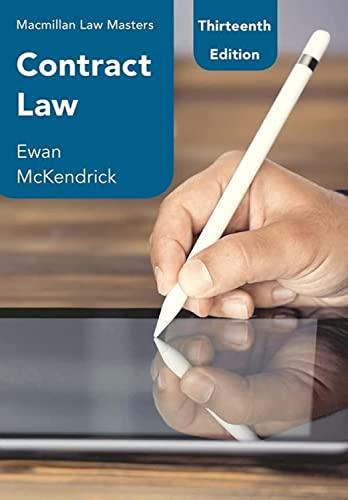Question
QUESTION ONE A major change brought about by the Fair Trading Amendment Act 2013('FTAA 2013') was to the way in which the purpose of the
QUESTION ONE
A major change brought about by the Fair Trading Amendment Act 2013('FTAA 2013') was to the way in which the purposeof the Fair Trading Act1986('FTA 1986') had been re-stated.
(a)What had been the original statement of purpose for the FTA 1986 when it was first made law in 1986 and where in the FTA 1986 could this statement be found?
(b)As a consequence of the FTAA 2013, what is the current statement of purpose for the FTA 1986?
(c)Where in the FTA 1986, is this revised statement of purpose of the Act now found and what is the significance of where in the Act the restatement of purpose is found?
(d)The restatement of purpose seeks to contribute to the trading environment in which 3 specific characteristics are sought to be protected or promoted.
What are these specific characteristics and what are the 4 ways in which the Act states that it seeks to contribute towards achieving these purposes?
QUESTION TWO
The Commerce Commission ('CC') has been recognised as having a significant role in the context of the FTA 1986.
(a)What particular Act and specific section in that Act provides the legal basis for the creation and existence of the CC?
(b)Outline the important roles that the CC has in the context of the FTA.
(c)Despite the role of the CC, the FTA has been described as one which is to a significant extent, "self-policing"
Explain why the FTA has been so described and in what ways has the FTA been self-policed?
QUESTION THREE
Animportant requirement in respect of conduct which the FTA seeks to regulate, is that such conduct must occur "in trade".
(a)Outline how the FTA deals with the meaning of the phrase, "in trade" and what does the phrase in fact mean?
(b)Why has the meaning given to the phrase,"in trade" stated to have been further complicated?
(c)What is the basis for the statement that the phrase,"in trade', is to be broadly interpreted?
(d)In what way do the court decisions in Pharmaceutical Management Agency Ltd v Astra Pharmaceuticals(NZ) Agency Ltd(1999 6 NZBLC 102,771 and Body Corporate 202254 v Taylor[2009] 2 NZLR 17, support the view that the phrase, "in trade', is to be broadly interpreted?
QUESTION FOUR
What is the intended effect of the 2013 amendment found in s 28B of the FTA 1986, and what if any relevance does the amended s 28B have in relation to the phrase, "in trade"?
QUESTION FIVE
The sections contained in the FTA 1986 are found under various Parts of the Act.
(a)How many Parts in total are there in the FTA 1986?
(b)Outline what each Part of the FTA, seeks to deal with?
(c)Under which Part of the FTA can the specific provisions of sections 10 and 13 be found and what do these two particular sections state?
(d)What may an employer be potentially liable for under s 12 of the FTA and what is its significance for businesses?
(e)What are the specific types of conduct which s 13 prohibits and of the (10)ten paragraphs, which particular paragraph prohibits misleading representations in respect of the origin of goods?
Step by Step Solution
There are 3 Steps involved in it
Step: 1

Get Instant Access to Expert-Tailored Solutions
See step-by-step solutions with expert insights and AI powered tools for academic success
Step: 2

Step: 3

Ace Your Homework with AI
Get the answers you need in no time with our AI-driven, step-by-step assistance
Get Started


